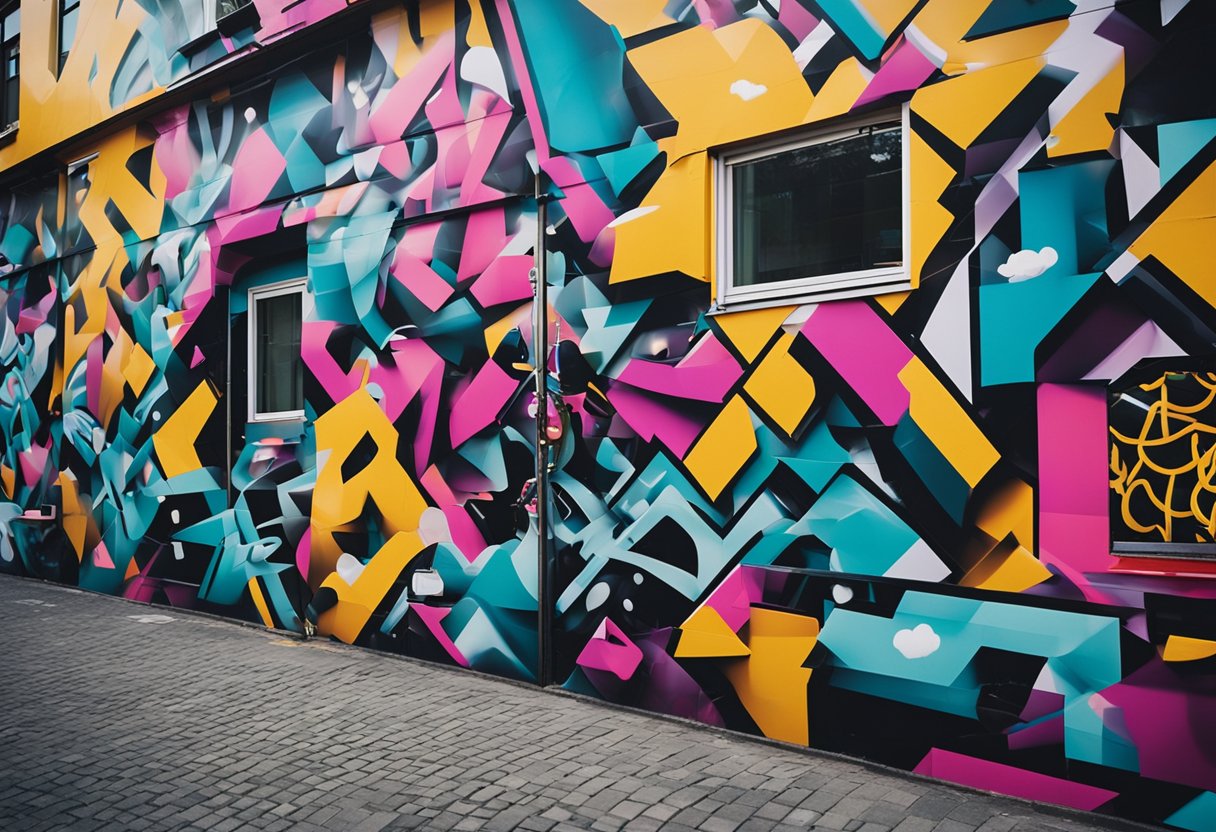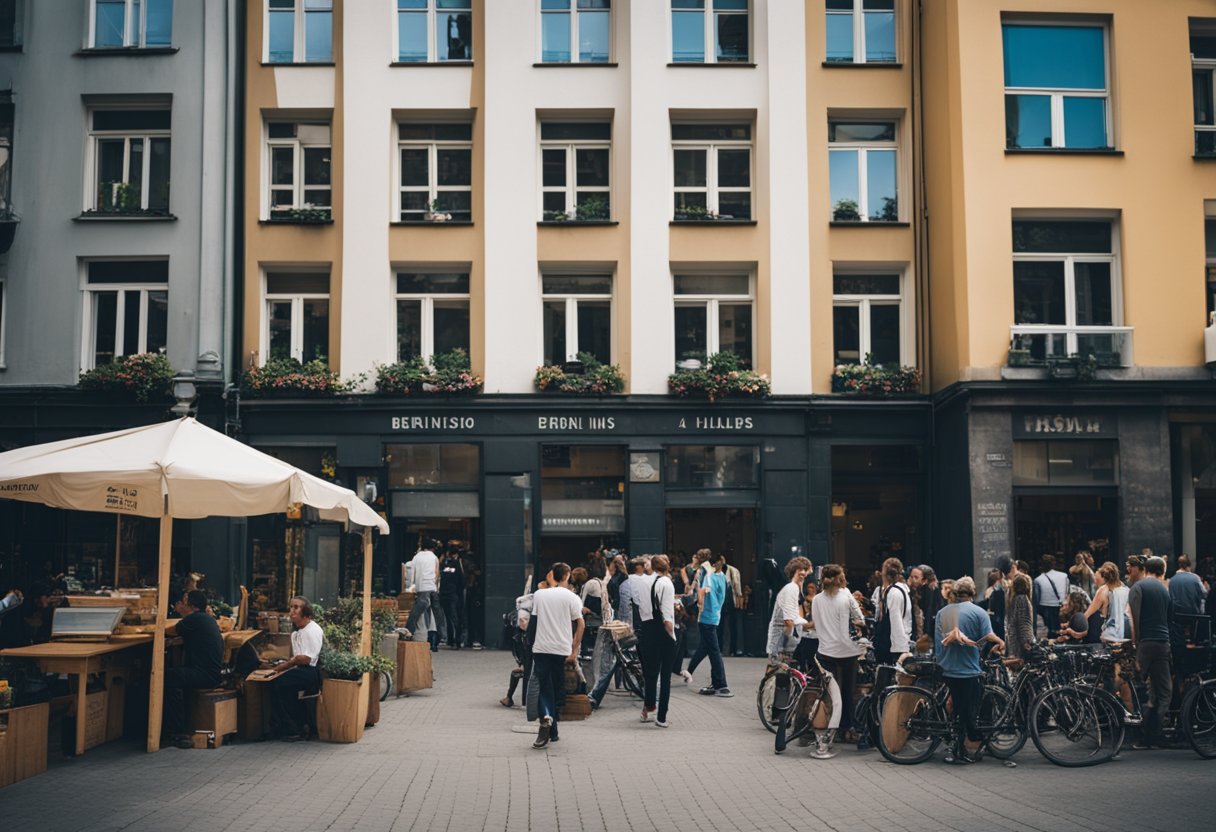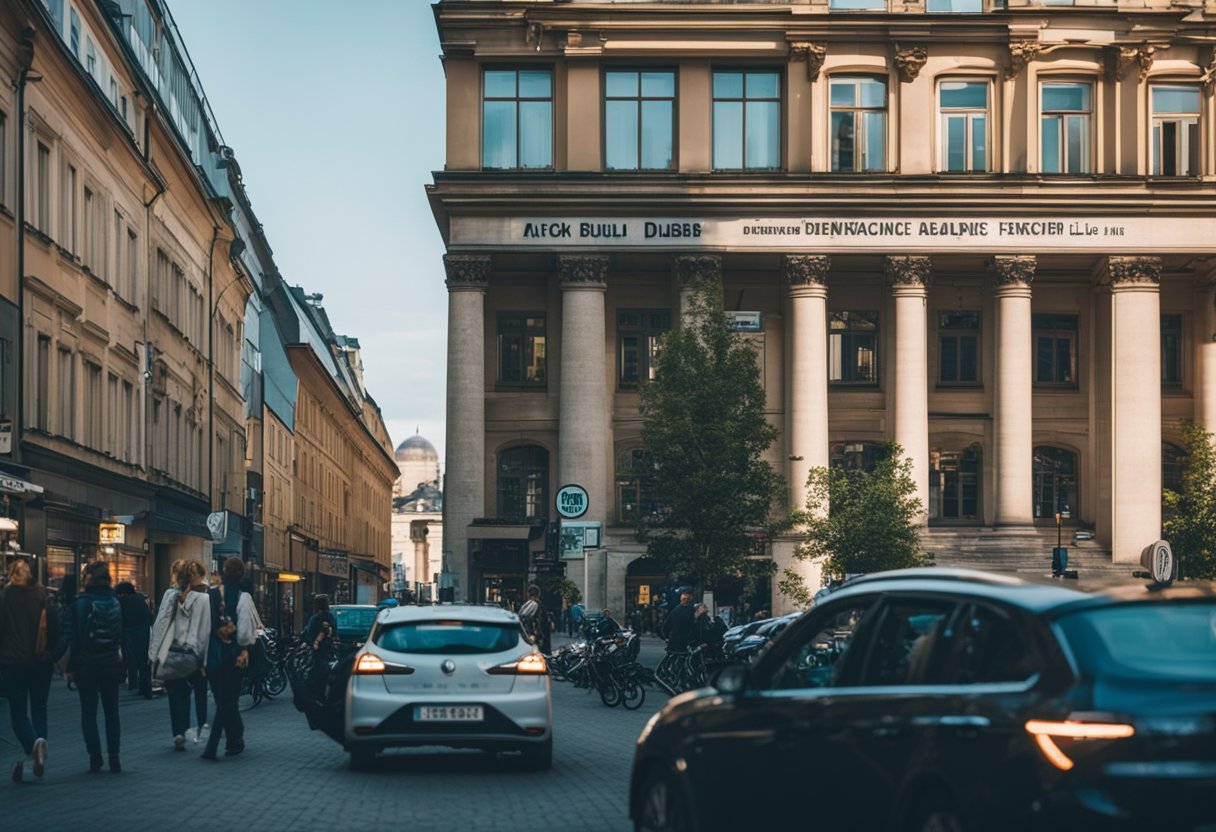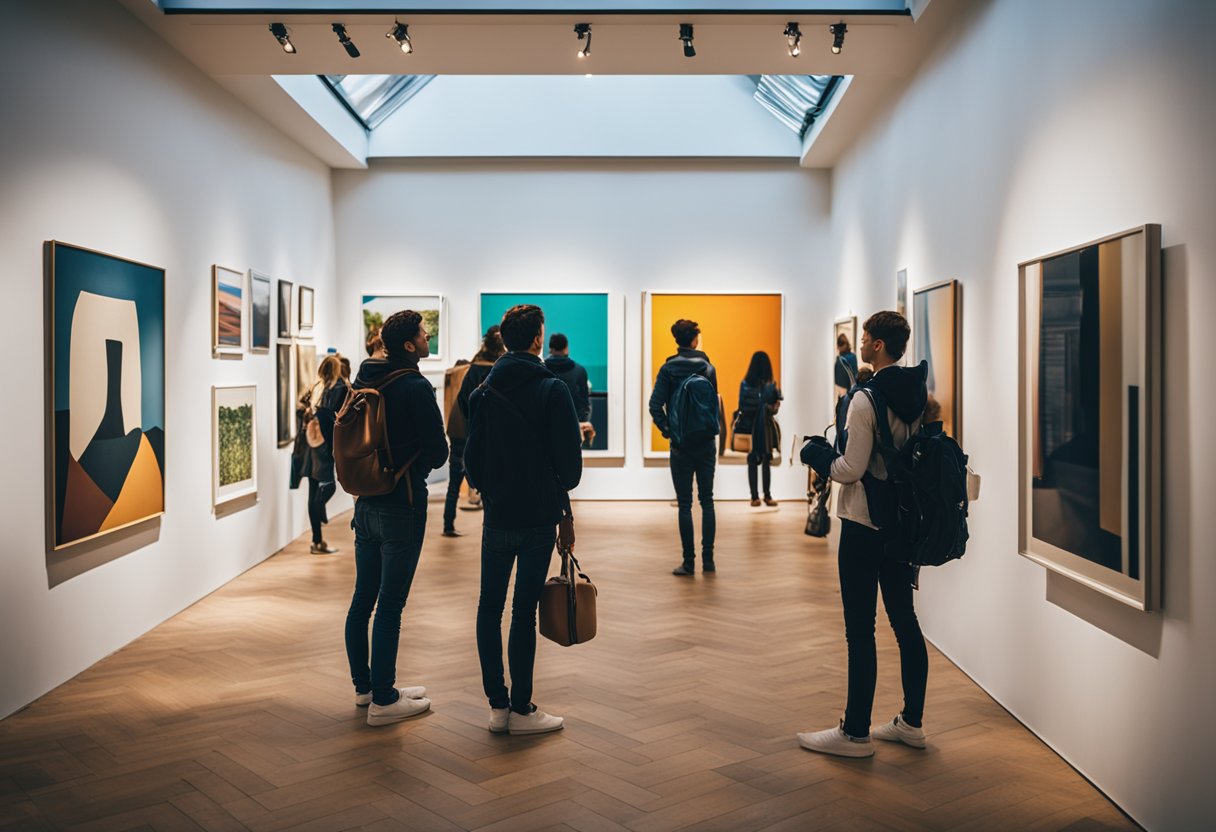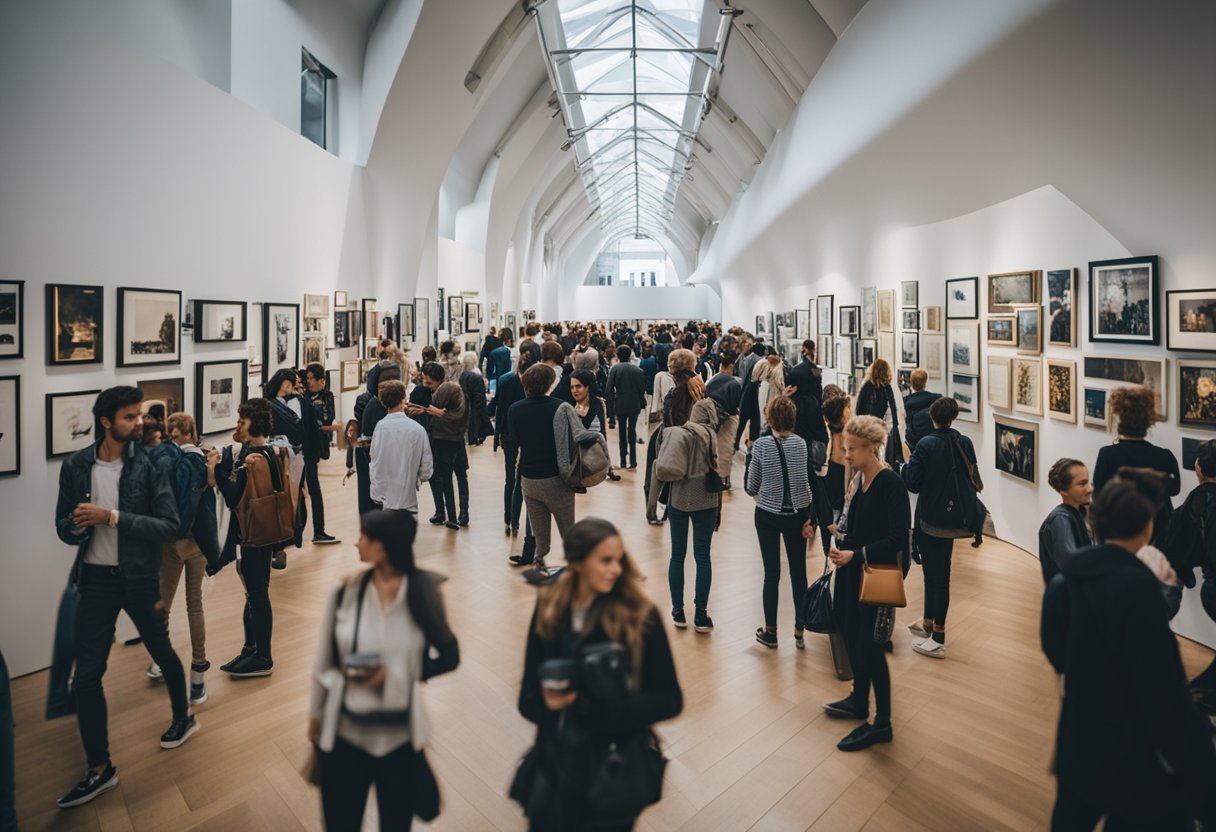We discuss the thriving scene contemporary art Berlin presents to locals and visitors, a city that has long been a magnetic point for artists and creatives from across the globe. With an atmosphere that is ripe for artistic expression, the Berlin art world is characterized by its dynamic spaces ranging from high-profile galleries to underground studios.
It is in this metropolis that history and avant-garde come together, giving rise to a complex and diverse art landscape that challenges the traditional confines of artistic discourse.
Our exploration brings us to the very heart of Berlin’s modern artistic identity, where contemporary fine arts flourish and innovative exhibitions are commonplace. Galleries in Berlin are known for showcasing a spectrum of cutting-edge art across various mediums, highlighting works by acclaimed international artists as well as emerging local talent. This diversity not only demonstrates the inclusive nature of Berlin’s contemporary art scene but also adds to the rich cultural fabric of the city.
In Berlin, every corner offers an opportunity for artistic discovery, with hundreds of galleries presenting contemporary art in styles that span from the classical to the experimental. Whether it’s the subtle conversations captured through paint, the immersive experience of performance art, or the thought-provoking installations that question societal constructs, the contemporary art of Berlin invites profound reflection and engagement, solidifying the city’s role as a pivotal hub for modern creativity.
Historical Context of Berlin Art
Berlin has a rich and dynamic history that is deeply reflected in its contemporary art scene. As we explore the historical context of Berlin art, it’s important to recognize how the city’s division and reunification have shaped artistic expression.
Post-Wall Evolution
After the fall of the Berlin Wall, the city’s art landscape transformed dramatically. We saw artists from across the Berlin and beyond flocking to the city, eager to occupy its vast empty spaces, particularly in East Berlin. These areas became hotbeds for artistic experimentation, with former industrial buildings and abandoned spaces repurposed into studios, galleries, and loft living spaces. This period marked a rebirth of the city’s cultural life, fostering a thriving art scene known for its diverse and avant-garde spirit.
Influence of Berlin Wall on Art
The Berlin Wall itself, while a symbol of division, also became a canvas for political expression and is now home to one of the longest-lasting open-air galleries in the world, the East Side Gallery. Here, murals painted on remnants of the wall express themes of freedom and reconciliation and have become integral to Berlin’s identity as a city of arts. Street art in Berlin further embodies the spirit of rebellion and freedom, emerging from the shadows of the Cold War to become one of the most vibrant facets of the city’s art scene.
Key Districts and Venues
In our exploration of contemporary art in Berlin, we focus on three pivotal areas: Mitte, Kreuzberg, and West Berlin. Each district boasts its own unique contributions to the art scene, housing several esteemed galleries and exhibition spaces.
Mitte
Mitte forms the cultural core of Berlin’s art landscape, where the convergence of history and modernity creates a vibrant exhibit of creativity. We find Auguststraße here, often considered the heart of Berlin’s gallery district, with prestigious institutions like the KW Institute for Contemporary Art nurturing cutting-edge art. Another prominent venue is the Berlinische Galerie, known for its collection of modern art, photography, and architecture.
- Galleries to Visit in Mitte:
- KW Institute for Contemporary Art
- Berlinische Galerie
- Various galleries along Auguststraße
Kreuzberg
Kreuzberg, with its bohemian roots, is a district teeming with energy and artistic expression. The Akademie der Künste plays a significant role in supporting artists and hosting exhibitions that push the limits of contemporary art. The area is also home to numerous project spaces and pop-up exhibitions that reflect Kreuzberg’s dynamic and alternative spirit.
- Cultural Spots in Kreuzberg:
- Akademie der Künste
- Project spaces showcasing avant-garde and emerging art
- Street art that adds a raw, visual narrative to the district
West Berlin
Moving to West Berlin, we find the Hamburger Bahnhof, a former railway station turned museum, which now stands as a monument to contemporary art. This remarkable venue features extensive collections and temporary exhibitions that highlight both international and local talent. We must also acknowledge West Berlin’s contribution to cultivating a rich landscape for art, with spaces like the Neuen Nationalgalerie and the alternative art scene thriving in districts such as Neukölln and Wedding.
- Notable Venues in West Berlin:
- Hamburger Bahnhof – Museum für Gegenwart
- Neuen Nationalgalerie
- Artistic hubs in Neukölln and Wedding
Through these districts and venues, we gain insight into the diversity and depth of the contemporary art scene in Berlin. Each area brings its distinct flavor to the city’s cultural table, offering both art aficionados and newcomers an array of experiences to engage with modern creativity.
Major Events and Institutions
Berlin’s contemporary art landscape is vibrant and diverse. We have an impressive array of events and prominent institutions that play a pivotal role in the city’s art scene. Among these, Berlin Art Week, Berlin Biennale, and Gallery Weekend stand out as significant occasions that capture the essence of our rich artistic culture.
Berlin Art Week
Each year, Berlin Art Week serves as a central platform for our city’s dynamic art scene, highlighting the latest at key venues across Berlin. For art enthusiasts and industry professionals alike, this event is a testament to Berlin’s stature as a global hub for contemporary art. Art lovers can also partake in workshops and events, providing an immersive experience into the city’s creative pulse. Learn more at the official Berlin Art Week website.
Berlin Biennale
The Berlin Biennale is a prestigious international event that occurs bi-annually, showcasing cutting-edge contemporary art from around the world. It’s a significant event where artists, critics, and the public converge to engage with the most progressive and thought-provoking artworks of our time. This gathering not only brings art to the forefront but also sparks discussions on current global issues through the lens of creativity.
Gallery Weekend
During Gallery Weekend, we witness an extraordinary collaboration among galleries to celebrate contemporary art. This event is all about discovery and connection, presenting an extensive range of exhibitions and installations that cater to seasoned collectors and curious onlookers alike. It’s a distinct opportunity for attendees to delve into the latest exciting developments within Berlin’s art community. Discover more about Gallery Weekend and plan your visit here.
Our city’s dedication to these major events and institutions underscores Berlin’s ongoing commitment to fostering and sharing the vibrancy of contemporary art with a global audience.
Prominent Artists and Their Impact
Berlin’s contemporary art scene is a vibrant tapestry woven from the creative threads of internationally acclaimed artists and local rising talents. These individuals have not only enriched the city’s cultural landscape but have also left a profound impact on the global art community.
Internationally Acclaimed Artists
Berlin has long been a magnet for established artists who have gained international recognition. Ai Weiwei, a name synonymous with politically charged art, chose Berlin as a place of work, leaving an indelible mark on its artistic identity. Olafur Eliasson, known for his large-scale installation works, is another resident contributing to the city’s status as a global art hub. His works, which often incorporate elements of light and weather, invoke a deep sense of reflection and engagement with the natural world.
Wolfgang Tillmans has also become a household name, both in Berlin and across the world. His photographic works, characterized by their exploratory nature and innovative compositional techniques, have redefined the boundaries of photography as an art form.
Local Rising Talents
Emerging artists in Berlin are carving out their own spaces and making waves within the art community. Leda Bourgogne’s work, for example, skillfully intertwines themes of poetry and textile, bringing forth a unique aesthetic that’s gaining attention.
In juxtaposition to the emerging talents, established painters like Georg Baselitz and Neo Rauch have laid the groundwork for a thriving art scene within the city. With Baselitz’s intense, inverted figures and Rauch’s enigmatic depictions of East German life, they’ve offered new narratives in painting that continue to influence both peers and proteges.
Taking inspiration from these pioneers, artists such as Jonathan Meese and Jeppe Hein contribute to the ongoing dialogue in Berlin’s art scene through their interdisciplinary and interactive works. The presence of these artists fosters an environment where innovation is constant, and the exchange of artistic ideas is ceaseless.
Collections and Collectors
Berlin’s contemporary art scene is distinguished by an exceptional array of both public and private collections. We observe that notable collectors like Christian Boros have significantly shaped this landscape through their private collections. Now let’s explore the distinctive features that Berlin offers through its public and private art domains.
Public Collections
Public collections in Berlin provide a broad audience with access to contemporary art. Sammlung Marx, for instance, comprises a compelling selection of modern masterpieces. These prestigious works are often displayed in esteemed institutions such as the Hamburger Bahnhof – Museum für Gegenwart, enriching Berlin’s cultural fabric. The public collections serve not just as exhibits but also play a crucial role in art conservation and cultural education.
Private Collections
On the other side, private collections offer a more personalized glimpse into the world of contemporary art. The Sammlung Boros collection, housed in a repurposed bunker, is a prime example of this intimate experience. Propelled by the passion of collectors like Christian Boros, these private spaces exhibit a diverse range of current art trends. Viewing opportunities are often limited, which makes them highly sought-after experiences for enthusiasts and connoisseurs.
Artistic Mediums and Styles
In Berlin, we observe a diverse array of artistic expressions that define the contemporary art scene. From traditional forms like painting and sculpture to the evolving realms of new media and digital art, alongside the captivating storytelling through photography and film, each medium enriches the city’s cultural landscape.
Painting and Sculpture
Berlin’s contemporary painting scene often features bold explorations that extend beyond conventional boundaries, including contributions to pop art and visual arts. Sculptures in the city, both in galleries and public spaces, range from classical forms to avant-garde installations that challenge viewers’ perceptions.
- Paintings: Embracing a spectrum from abstract to hyperrealism.
- Sculptures: Shifting from static figures to interactive pieces.
New Media and Digital Art
We witness a surge in the adoption of new technologies within the art world here. Media art and video installations provide immersive experiences that are rapidly becoming integral to the Berlin art scene.
- Video: Utilized for storytelling and creating dynamic visual experiences.
- Digital Art: Merges traditional artistic techniques with cutting-edge digital tools.
Photography and Film
Berlin’s status as a hub for photography and film is well-recognized, capturing both the historical depth and contemporary pulse of the city. Photography exhibits range from photojournalism to conceptual art, while filmmaking often reflects the complexities of modern life.
- Photography: Showcases a range of styles, from documentary to fine art.
- Film: Offers a captivating lens on societal narratives and personal stories.
We find that each of these mediums and styles carries its own significance, collectively shaping the unique artistic identity of Berlin.
Interaction with Other Cultural Aspects
In Berlin, the contemporary art scene is intricately woven into the fabric of the city’s diverse cultural landscape. We find that through mindful integration with architecture, music, literature, and interdisciplinary efforts, art takes on new dimensions of meaning and impact.
Architecture and Urban Spaces
The architecture of Berlin reflects a chronological tapestry of history, where contemporary art installations nestle within and against the backdrop of modern and historic buildings. Our cultural experiences are enriched by the deliberate juxtaposition of art within Berlin’s urban spaces. Visitors can explore how the city’s contemporary art spaces, like those found during the Gallery Weekend, push boundaries and provide a unique perspective on architecture and urban exploration.
Music and Performing Arts
Music and performing arts in Berlin carry a sound and rhythm influenced by the city’s artistic heartbeat. We witness an exciting fusion where contemporary visual artists collaborate with musicians and performers. The interdisciplinary projects often result in innovative performances that challenge our perceptions of art and sound, as seen in the Thought-Provoking Work by Tino Sehgal, which proposes entirely new ways of experiencing art and performing arts.
Literature and Interdisciplinary Projects
Berlin’s contemporary art scene is not limited to visuals; it extends into the realms of literature and interdisciplinary projects. We see contemporary themes being discussed in literary forums, often accompanied by visual art or performance. This dynamic mix offers a rich ground for interdisciplinary collaboration, which often garners attention from the press and gets amplified by platforms such as Facebook, further integrating itself into the digital and global culture. Literature in Berlin, alongside art, becomes another reflective surface for the cultural complexity of the city.
Representation and Critique
In Berlin’s vibrant contemporary art scene, where galleries showcase a plethora of exhibitions and installations, our focus is on the roles that curatorial practices and art criticism play in shaping the discourse and reception of fine art.
Curatorial Practices
Our approach to curation involves making conscious and informed decisions that contribute to a broader conversation within the art community. During events such as Gallery Weekend, we see a surge of art lovers descending upon the city to engage with new expressions of creativity. The curatorial strategies employed can significantly influence the way artworks are presented and interpreted—be it through thematic exhibitions or artist retrospectives. Our curatorial choices not only reflect our aesthetic and conceptual preferences but also respond to social and political currents, amplifying the voices that need to be heard within the labyrinth of visual culture.
Art Criticism and Media Response
The interplay between art criticism and media response is integral to our understanding and appreciation of contemporary art. We closely monitor the press reviews post-installation, as they often serve as a barometer for public sentiment and reception. Art criticism, in our view, is not just about passing judgment but also about engaging with art on a deeper level, fostering a dialogue that challenges both the artist and the audience. The media response thus becomes a narrative that can either sustain or contest the intentions behind our curatorial endeavors, impacting both current perceptions and future legacies.
Global Perspective
In our exploration of Berlin’s contemporary art scene, it’s evident that the city’s cultural landscape has been shaped by diverse global influences. Our gallery walks reveal the imprints of European tradition fused with the pulsating rhythms of Africa, the intricate storytelling of Asia, and the vibrant expressions from the Americas.
European Influence
Notably, Berlin’s contemporary art mirrors Italy’s rich artistic heritage, echoing the conceptual revolutions from the European avant-garde. The veins of classical European art run deep through Berlin, a city that has long served as a confluence of ideas from across the continent, evident in the ever-evolving capital’s gallery and museum exhibits. Classic European techniques blend with modern aesthetics, creating a fusion that feels both familiar and fresh.
Connection with the Americas and Africa
Our attention also gravitates toward the transatlantic dialogue between Berlin and regions like South America, where inspirations echo from deep in the heart of Peru to the cosmopolitan centers of Brazil. Africa’s influence is equally compelling, with contemporary artists often drawing upon themes from countries like Egypt, integrating rich narratives and traditional iconography into their works that challenge and enrich the Berlin art scene.
Asia’s Impact on Berlin’s Contemporary Art
Lastly, Asia’s impact is discernible through myriad exhibitions and artworks throughout Berlin. The delicate balance of tradition and modernity in Asian art provides stark juxtapositions, weaving together historical narratives and cutting-edge trends. This creates a multidimensional art experience, reflective of the rich tapestry of cultures that characterizes the thriving artistic metropolis that is Berlin.
The Business of Art
In Berlin, the art market reflects the city’s dynamic and diverse cultural landscape, with particular emphasis on contemporary pieces. As we navigate this topic, we’ll delve into the current market trends and examine how art fairs and sales contribute to the vibrancy of the Berlin art scene.
Market Trends
The Berlin art market is characterized by its innovative spirit, often setting the pace for contemporary art on an international scale. Galleries like König Galerie, established by Johann König, and Galerie Eigen + Art have a significant influence by promoting cutting-edge artists and shaping market preferences.
- Contemporary Fine Arts (CFA) and Galerie Max Hetzler excel in bringing diverse and provocative works to the forefront.
- Sprüth Magers and Galerie Thomas Schulte are distinguished for their curated collections that often push boundaries, reflecting current trends.
The demand for contemporary works by emerging artists is on the rise, with collectors keen on acquiring pieces that both challenge and excite. Names associated with these trends include Schinkel Pavillon and Haus am Waldsee, known for their forward-thinking exhibitions.
Art Fairs and Sales
Art fairs play a pivotal role in the commerce of art in Berlin, serving as major hubs for the display and sale of contemporary work.
- The Berlin Biennale attracts a global audience, boosting sales and increasing visibility for local galleries.
- Annual events like Positions Berlin Art Fair and Art Berlin Contemporary bolster the market by facilitating connections between collectors, galleries, and artists.
Specifically, galleries such as BQ Berlin and Galerie Zero capitalize on these events to expand their reach. The sales at these fairs not only reflect the health of the Berlin art market but also contribute significantly to the ever-evolving dialogue surrounding contemporary art.
Art in Public Spaces
When we explore contemporary art in Berlin, we see a city alive with creativity. Notably, Berlin’s public spaces host a dynamic range of artworks—impactful urban street art and thoughtful installations enhance the cityscape.
Urban Street Art and Murals
Berlin’s urban landscape is a canvas for street art that speaks to our society’s pulse. Urban Spree is a cultural hotspot where we find a constantly evolving tapestry of murals. It is a prime example of how the city’s walls reflect the vibrancy of its creative community. Crucial to the narrative of street art in Berlin, pieces often tackle themes like politics and social justice, inviting onlookers to engage in a dialogue.
- Dark Matter: A mural that captures eyes for its thought-provoking imagery.
- East Side Gallery: Here, the remnants of the Berlin Wall serve as an iconic monument clad in works from various artists, telling stories of freedom and reconciliation.
Public Installations and Exhibitions
The intersection of public spaces and art in Berlin goes beyond murals and graffiti. Joseph Beuys instilled the idea that art could serve as a vehicle for change, and our city’s installations often embody this ethos.
- Richard Serra’s awe-inspiring sculptures redefine our urban landscapes and challenge conventional perceptions of space.
Public exhibitions are also woven into the daily life of the city. They transform ordinary places into venues of contemplation and reflection, inviting us to pause and interact with art outside the confines of traditional galleries. By turning public spaces into exhibition sites, we gain new perspectives and experiences that only art in the open can provide.
Influence and Challenges
As we explore the contemporary art scene in Berlin, it’s crucial to recognize both the pervasive influence of the city’s unique history and the various challenges that today’s artists face. Berlin’s role as a cultural capital is well-documented, nurturing creativity and cutting-edge art through a rich tradition of political and social commentary.
Political and Social Commentary
Berlin has long been a focal point for artists who engage with political and social issues. The city’s turbulent history, marked by periods of division and unification, has imbued art with a profound sense of purpose. Here, contemporary art goes beyond aesthetics; it serves as a medium for critique and reflection on societal shifts. Our galleries and public spaces often display works that challenge the status quo and spark dialogue regarding current events and cultural shifts.
Artistic Challenges in the Present
Despite its reputation as a hub for artists, Berlin is not without its trials. The commercialization of art and gentrification pose significant challenges. Rising expenses can stifle the dynamism that once defined Berlin’s art scene. Maintaining the city’s status as a haven for creativity requires both support for the arts and practical solutions to these economic hurdles. Furthermore, artists in Berlin are continually pushed to redefine the boundaries of contemporary art, ensuring the scene remains at the forefront of innovation.
The Future of Contemporary Art in Berlin
As we examine the landscape of contemporary art in Berlin, we foresee a thriving and dynamic environment. Our anticipation is for a flourishing scene bolstered by emerging artists and a steadfast commitment to sustainability and innovation.
Emerging Trends
In the realm of contemporary art, Berlin stands as a beacon of innovation, continuously welcoming a wave of emerging artists. Our galleries and collectives have become incubators for bold, new ideas, as we witness a trend toward multidisciplinary collaboration. This cross-pollination among artistic mediums is not merely a trend but a reshaping of the Berlin art scene’s very fabric, fostering an ecosystem where innovation thrives.
Sustainability and Innovation
Berlin’s contemporary art scene is becoming increasingly intertwined with sustainability, recognizing our role in fostering an environmentally aware cultural narrative. Innovative use of recycled materials and sustainable practices in art production is not just a passing inclination; it illustrates our deep-seated responsibility towards the planet. Our institutions and studios are implementing green policies and showcasing works that reflect and critique society’s consumption patterns.
